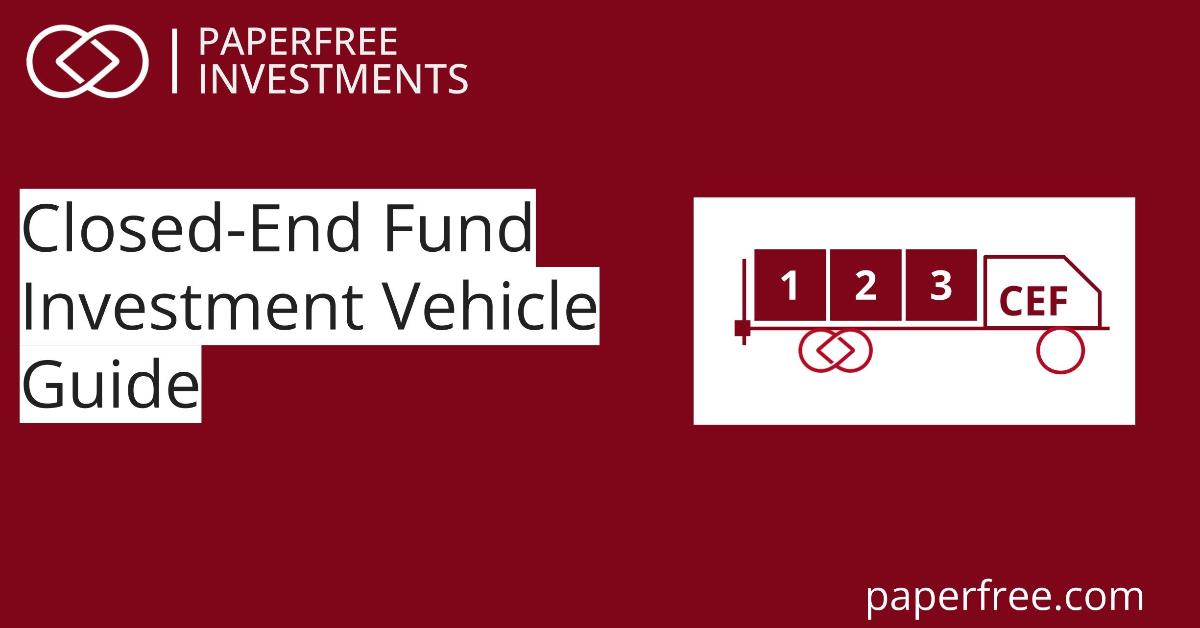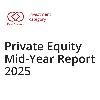A Guide to Investing in Closed-End Funds
Learn about closed end funds. Explore the world of closed-end funds and gain valuable insights into effective investment strategies with Paperfree.com. Discover how closed-end funds can play a crucial role in diversifying your portfolio and achieving your financial goals. This comprehensive guide covers the advantages, risks, and essential aspects of investing in closed-end funds, brought to you by Paperfree.com.last updated Wednesday, December 31, 2025
#closed end funds #close ended funds
| | by John Burson | Content Manager, Paperfree Magazine |

QUICK LINKS
AD
Get Access to Real Estate Investment Opportunities
Closed-end funds are a unique yet often overlooked investment vehicle for achieving financial goals. These funds are particularly advantageous as they combine the best features of mutual funds and individual stocks, providing investors with a specialized approach to income generation and diversification.
Although investors have been trading closed-end funds for nearly a century, many do not fully understand how these funds operate and their significance as a viable investment choice.
In this article, we will demystify closed-in funds by
- Clearly defining closed-end funds.
- Explaining how closed-end funds differ from open-end funds.
- Discussing their benefits.
- Covering the risks.
- Describing the type of investors most likely to invest in closed-end funds.
- Answering the most common questions about this investment.
What is a Closed End Fund?
Closed-end fund definition:
A closed-end fund (CEF) is an investment vehicle that raises capital for its initial investments by issuing a predetermined / fixed number of shares through an initial public offering (IPO) [1].
After the IPO, the fund doesn't issue new shares or redeem outstanding ones. Only a fixed number of shares offered in the IPO become available for trade on the stock exchanges.
Since investors invest money in only a limited number of shares, there are no new cash flows into the fund, and little flows out.
These funds include a variety of municipal bond funds and global investment funds.
In addition, closed-end fund portfolios are more likely than open-end funds to contain alternative assets, such as
- real estate,
- derivatives,
- futures,
- or foreign currencies.
Key Characteristics
- CEF has a fixed number of shares
- CEF can trade on exchanges
- CEF trades at a premium or discount from net asset value (NAV)
.jpg)
Fig 1. A Closed-End Fund has a fixed number of shares
_o.jpg)
Fig 2. Closed-End Fund trade at premium +/- discount
.jpg)
Fig 3. Benefits of Closed-End Funds
Benefits of Closed-End Funds
Closed-end funds provide numerous advantages to investors, especially those looking to diversify their portfolios and potentially boost their financial returns. Below is an overview of the most significant benefits.
- Professional Management
Professional portfolio managers or investment teams bring investing experience and research skills to CEF management. They control the fund's strategic investment decisions and actively adjust their holdings based on market conditions and historical data. Portfolio managers’ expertise and maneuvers can lead to favorable investment outcomes. - Diversification
Closed-end funds generally maintain a diversified portfolio of assets. This advantage helps investors distribute risk across different asset classes, industries, and geographic regions, reducing volatility. - Liquidity
Since investors trade shares of closed-end funds on the stock exchanges, you can buy or sell your CEF share anytime during the trading day at the current market price. This liquidity provides the flexibility to adjust your positions as market conditions change. - Income Generation
Many closed-end funds use an income-focused asset allocation to provide investors with regular income through dividend distributions, including dividends, capital gains, and returns of capital. These funds appeal to income-oriented investors, such as retirees and those seeking passive income. - Leverage
Some closed-end funds use leverage, meaning they borrow money to invest in additional assets. This strategy can increase the fund's risk and amplify returns in a favorable market. Funds that use a leverage strategy typically appeal to investors with high risk tolerance. - Discounts and Premiums
Closed-end funds often trade at prices that differ from their net asset value (NAV). These price deviations can create opportunities to increase your returns by buying shares at a discount to NAV.
Risks of Closed-End Funds
As we just covered, closed-end funds offer many benefits. However, before adding them to your portfolio, you should also assess several associated risks. Here are the primary risks related to closed-end funds.
- Market Risk
Regarding market risk, closed-end funds are no different from stocks and bonds. Financial market fluctuations can cause declines in the funds' NAV, potentially triggering sell-offs [4] or investor losses. - Interest Rate Risk
Many closed-end funds are sensitive to changes in interest rates, especially those that invest in fixed-income securities. Interest rate changes can push down bond prices and decrease NAV, possibly impacting the fund's returns. - Leverage Risk
Like with any debt-backed venture, leverage-enabled investments carry the risk of magnified losses during market downturns. When some closed-end funds use leverage to amplify returns, they must factor leverage risk into the risk/return ratio calculation [5]. - Discount and Premium Risk
Closed-end funds often trade at varying prices above or below their NAV. Although buying shares at a discount can be rewarding, the opposite is true if the discount widens or persists. This possibility could result in capital losses. - Distribution Risk
Income-oriented closed-end funds may be motivated to maintain high distribution levels. If they lack the income to cover distributions, these funds can erode their NAVs over time, potentially destabilizing their sustainability. - Illiquidity Risk
You may not have the same liquidity as individual stocks when you trade closed-end funds on the stock exchanges. Some of these funds may have limited trading volume, making it more challenging to buy or sell at your price point. This can be an even more formidable challenge in a turbulent market.
What Type of Investors Do Closed-End Funds Attract?
Closed-end funds have unique characteristics and benefits, making them suitable for specific investor types. Let's discuss the kind of investors most likely to invest in closed-ended funds.
- Investors by Qualifications
Due to their complexity and special conditions, investing in this type of fund requires the following:- An educated understanding of financial markets.
- A willingness to research and analyze closed-end funds effectively.
- Ability to navigate the nuances associated with these investments.
- The skill to identify opportunities, such as discounts to NAV.
- Being able to make informed decisions.
Even though you don't have to be an accredited investor, it certainly helps to be at the experience level of one. For example, closed-end funds often trade at discounts or premiums to their NAV. A skillful portfolio manager can leverage these opportunities to deliver returns above average. However, it helps if you know enough about the market to trust the manager’s decisions.
- Investors by Preference
Many closed-end funds focus on income generation. This aspect appeals to investors seeking regular passive cash flow, such as retirees and those who depend on investments for income. Investors with long-term investment horizons value this fund's stability and income-generating capabilities.
Many closed-end funds attract both risk-neutral and risk-averse [6] investors. However, funds that use leverage to amplify returns are better suited for investors with a high risk tolerance. These funds also attract retail and institutional investors seeking diversification, as they typically hold diversified assets across sectors and regions. - Investors by Objectives and Goals
Many investors setting up an estate plan find closed-end funds to be efficient wealth-transfer mechanisms. They provide opportunities to pass on investments with income-earning potential to beneficiaries, but due diligence is essential to ensure beneficiaries select funds that meet their needs.
Since there is the potential to buy closed-end funds at a discount, contrarian [7] and value investors often use these funds for opportunities to purchase shares priced below their NAV and profit from the potential appreciation. These funds also appeal to liquidity-seeking traders because these investors can trade the funds on the stock market, which is subject to supply and demand.
Additionally, tax-conscious investors can benefit from the tax-efficient structure of closed-end funds, particularly if they aim to minimize their tax liabilities.
Closed ended funds vs open-ended
How Closed-End Funds Differ from Open-End Funds?
A CEF is similar to an open-end fund in two significant ways.
- It invests in securities within a portfolio.
- It uses a manager to control investment activities.
However, the big difference is that CEFs don't receive a regular capital inflow when investors purchase shares. And these funds don't lose capital flow when investors sell shares.
Unlike open-end funds, there are no direct share trades with the sponsoring fund family after the initial public offering (IPO). Instead, trading only happens with investors in the market exchanges. Since closed-end funds cease providing new shares after the IPO, investors refer to the offering as "closed."
As a result, the only ways capital can flow out of a CEF are:
- Shareholder distribution,
- Bad investment decisions,
- When the fund makes a tender offer to repurchase shares,
- forced sales to meet leverage compliance limits,
- Fund liquidation.
Most traditional mutual funds and ETFs continually receive new investor money, issue new shares, and buy back shares from shareholders. On the other hand, closed-end funds use the stock exchange to make shares available for trade throughout the trading day.
Another significant difference is that open-end mutual funds use the portfolio's net asset value to price their shares at the end of each trading day. By contrast, the stock price of a closed-end fund is determined by the forces of supply and demand, as well as the fluctuating values of the fund's holdings.
Frequently Asked Questions
How do I invest in closed-end funds?
You can buy a closed-end fund just as you would buy a stock or bond through your broker, online, or brick-and-mortar. However, when you purchase shares in a closed-end fund IPO, your price will include a premium [8] to cover the expenses and fees paid for the offering. For example, suppose you paid $15 for a share with a $3.00 premium. In this case, you invested $12 in the fund during the IPO.
However, the most significant aspect of investing in closed-end funds is not a simple process. Instead, effectively investing in the right closed-end fund requires the following:
- In-depth knowledge of the risks and rewards of the CEF's investments
- Factoring in the fee expense
- Knowing whether the effective leverage is 35% or less of the assets
- Determining whether the distribution is primarily income-funded
- Finding out whether the discount to NAV is more significant than the average
Where Can I Find the NAVPS, and How Is It Calculated?
You can often find a fund's net asset value per share (NAVPS) near its price quote with your broker's online financial platform or other broker portals. Since the NAVPS is calculated daily, it may differ slightly from the fund's actual market price.
The calculation for NAVPS is the fund's net asset value (total assets minus liabilities) divided by the number of outstanding shares. Since closed-end funds don't add new shares, the number of outstanding shares typically remains constant. Investors use this metric to compare the fund's performance against market industry benchmarks, such as the NASDAQ.
What's the Difference Between a CEF NAV and Stock Prices?
The primary difference between CEF NAV and stock price involves their systems of measure. Common stock issued by a listed company derives its value from market demand only. On the other hand, the value of a closed-end fund depends on the amount of capital invested in the fund, the cost of running it, and its outstanding shares, as indicated by the NAVPS.
Unlike a stock price, the CEF NAV doesn't have a performance metric for the fund. Since the CEF distributes almost all the income and realized capital gains to the CEF shareholders, the NAV is ineffective in measuring fund performance. Instead, investors measure CEF performance by its total return, which includes the performance of underlying securities and dividend payment history.
Can I Invest in Closed End Funds Through ETFs and ETNs?
You can get exposure to closed-end funds with an exchange-traded fund or exchange-traded note investment. For example, Amplify High Income ETF (YYY) tracks the performance of the ISE High Income Index.
The ISE High Income Index lists 30 closed-end funds, ranked by income yield, discount to NAV, and liquidity. If you invested in CEFs through the Amplify High Income Fund, you would currently pay about $10.88 per share for a yield of around 2.4% [9]
What is the Best Price Position for a Closed End Fund?
The best time to buy shares in a closed-end fund is when its discount exceeds the average. On the other hand, paying a premium to invest in a closed-end fund is risky because you would be paying more than the underlying assets are worth.
Since individual investors primarily own closed-end funds, down markets usually spark high selling activity in these funds. This activity widens the closed-end fund discount to net asset value. Currently, investors can purchase shares of closed-end funds at discounts that are more significant than average.
What is The Most Compelling Reason to invest in a closed-end fund?
The most compelling reason to invest in closed-end funds is that many are available at bargain basement prices in specific periods. They can also trade below NAV and can pay double-digit yields. However, you must stay abreast of the market to take advantage of this opportunity.
Why Paperfree.com
Closed-end funds offer many advantages compared with stocks and mutual funds. However, they pose an equal number of risks that require considerable due diligence and informed decision-making. Paperfree.com can help you with this challenge. We are an investment company that provides access to vetted investment opportunities in real estate and private equity for individuals seeking optimal returns on their investments.
Our magazine section and subscription newsletters provide in-depth and updated investment information, as well as critical investment trends. To enhance your investor experience, sign up for Paperfree.com to get personalized content and access to wealth-building investment opportunities.
Sources
[1] Initial Public Offering/ Investor.gov. https://www.investor.gov/introduction-investing/investing-basics/glossary/initial-public-offering-ipo
[2] Net Asset Value/ Investor.gov. https://www.investor.gov/introduction-investing/investing-basics/glossary/net-asset-value
[3] Beginners’ Guide to Asset Allocation/ Investor.gov. https://www.investor.gov/additional-resources/general-resources/publications-research/info-sheets/beginners-guide-asset
[4] What is a Sell-Off? https://www.investopedia.com/terms/s/sell-off.asp#:~:text=What%20Is%20a%20Sell%2DOff,as%20market%20psychology%20turns%20pessimistic
[5] Risk/Reward Ratio/ Moneywise https://moneywise.com/investing/risk-reward-ratio-what-it-is-and-how-to-calculate-it
[6] What Is Risk Neutral? /Investopedia https://www.investopedia.com/terms/r/riskneutral.asp#:~:text=Risk%20neutral%20describes%20a%20mindset,risk%20averse%20to%20risk%20neutral.
[7] What is Contrarian Investing/ Forbes Advisor https://www.forbes.com/advisor/investing/contrarian-investing/
[8] At a Premium/Investopedia https://www.investopedia.com/terms/a/at-a-premium.asp
[9] ETFs Tracking ISE High Income Index https://etfdb.com/index/ise-high-income-index/
Pages Related to #closed end funds
- Learn About Accredited Investors, Benefits of Being an Accredited Investor | Paperfree

- Accredited investor real estate. Best investments for accredited investors.

- Private Equity Mid-Year Report 2025: Market Trends & Industry Analysis

- Semi-Liquid Funds: Evergreen Compounding Returns

Popular Page
Private Real Estate Funds - Investments to Drive Income and Capital Growth
Book a Free Complimentary Call
Search within Paperfree.com
real estate investing Investment Visa USA Investment Magazine Private Real Estate Funds real estate funds
